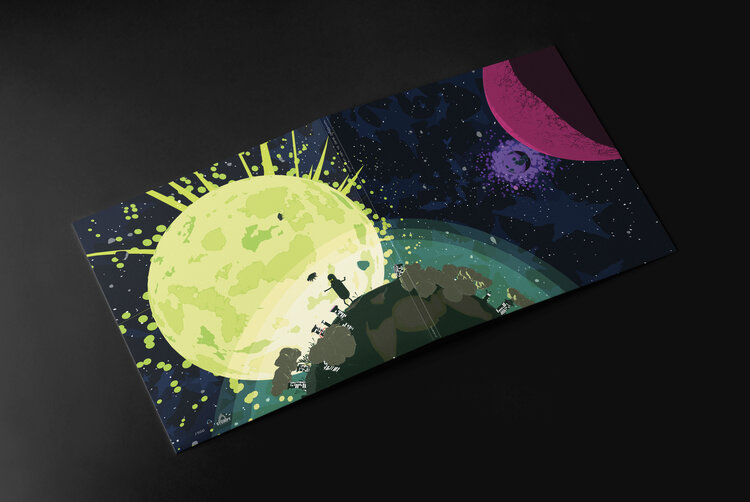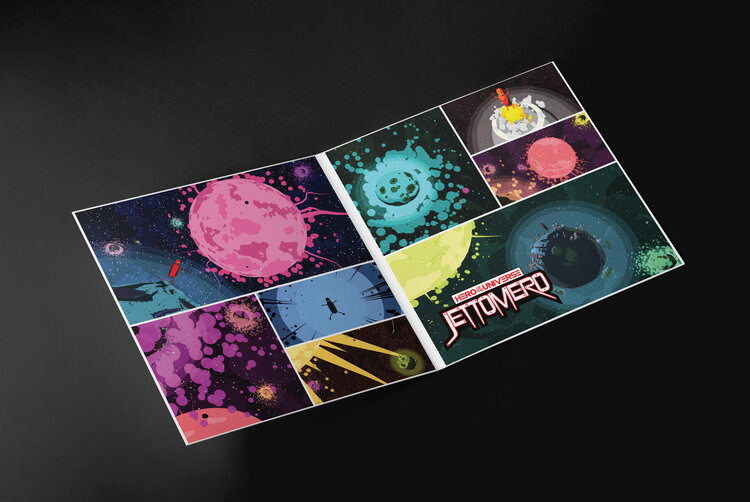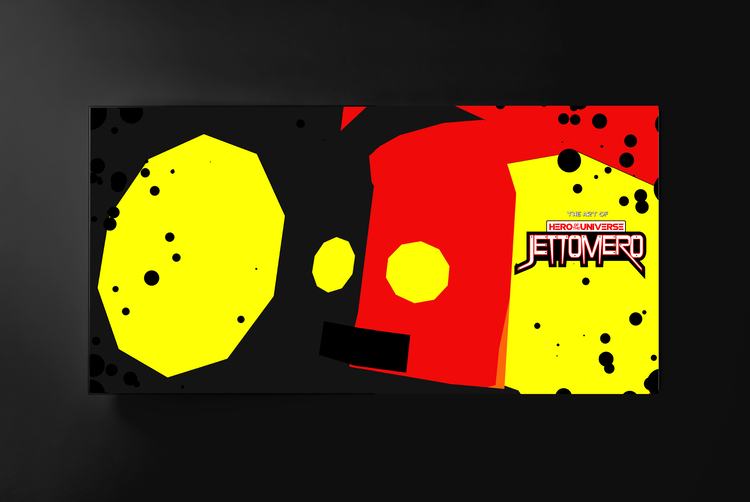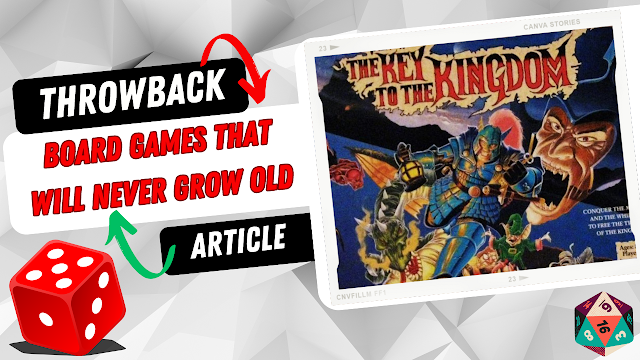Jettomero: Hero of the Universe – Vinyl Soundtrack
Composed by Gabriel Koenig
Purchase Link - https://www.stumpyfrog.com/
A warning that this article contains spoilers for the game Jettomero: Hero of the Universe, if you don’t want to read them but wish to know the outcome of the article - the soundtrack to Jettomero is fantastic and you should listen to it extremely intently and often.
I have so, so much to say about Jettomero. The game, and the developer behind it, Ghost Time Games (someone that I clearly need to interview for GF) – has had a serious impact on me, emotionally and I would go as a far as saying that they’ve altered the way that I approach all games, now knowing the full capabilities and emotional scope that they have in the right hands.
I have to not go into Tux and Fanny territory here, as this article could easily turn into a book so I’ll push that aside for now and fully concentrate on the big red robot.
I reviewed Jettomero a few months ago and was enamoured with the soundtrack, visuals and the character of Jettomero itself. I knew that Stumpy Frog Records was going to release a vinyl, and due to their generosity, I’m lucky enough to be in a position to discuss it here.
Of course, the thing with writing about a game is that the article is frozen in time, and so I wasn’t able to capture the effect that the game had on me in the following weeks and months as the brilliance of the concept of character and narrative really dawned on me. Well, not just dawned on me, but – and this is something that other games rarely do – got me thinking.
In the accompanying art book to the Jettomero soundtrack, developer (and composer) Gabriel Koenig states the following:
“I generally avoid trying to tell anybody how to think about my work, but if there is one thing I want someone to take away from Jettomero, it would be the idea that power and intention are not enough to make a positive change in the world. Understanding is critical, and it’s so often the most difficult part.
In our individual journeys to understand ourselves and our roles in the universe, I would hope that we all take the time to reflect on the impacts of our actions. It might even be the perfect thing to do whilst listening to this record.”
Jettomero is a huge, red robot whose design calls to mind ‘60s sci-fi movies. He ‘wakes up’ at the start of the game on a barren planet and effectively spends the game musing on his existence and meaning as he travels from planet to planet, innocently causing mayhem due to his size and clumsiness. Apologising profusely to those that he inadvertently harms as he fights ‘evil’ monsters to save the citizens.
I found the character of Jettomero to be a monumentally sad one. This poor, immortal and invulnerable creation that has untold power and only searches emptily for its meaning, only to eventually discover that effectively, THEY are the problem. I purchased the comic book from Gabriel Koenig, a short and beautifully presented comic that is comprised of images taken from the game’s photo mode – as is the artwork for this record, which I PROMISE I will gush about soon – and it captures Jettomero’s travels as he again muses on his existential crisis. I pick it up occasionally, as I thoroughly enjoy the frame of mind it puts me in, with just a few colourful pages.
In summary – when I think of Jettomero, I get a wave of melancholy at the thought of someone lurching uncertainly through their life, time and missed opportunities passing them by. It’s a simple message that I now realise was captured perfectly in Jettomero through sparse monologues, gorgeous visuals...and the music.
Gabriel Koenig has created a soundtrack seemingly specifically designed to emotionally resonate with me, and Stumpy Frog Records have – as always – delivered the goods in terms of packaging and presentation, with designs and extras that are not only perfectly in sync with the game but enhance and amplify it and its message, especially in regard to the art book, which does for your eyes what the music does for your ears, they are gifts to these organs.
The cover is created with fluorescent ink and glossily shows the in-game planets and stars in a graphic novel visual style. The record is also bound by a Japanese-style obi strip, a strip on which there is the title of the record accompanied by an image of our titular character jiving to the in-game tunes.
The rear of the obi strip states that the album is made up of 17 tracks on two deluxe LPs which are not only limited to 500 copies but are also hand-numbered. The back cover of the package is a nighttime illustration of Jettomero daintily approaching a clouded city, the only light coming from the windows of buildings and Jettomero’s round, yellow eyes. This is all in front of an enormous, engulfing planet behind them, the yellows and greens of its surface blaring out into the galaxy. The only hint that this is a record comes from the aforementioned hand-numbering and tasteful, silver Stumpy Frog Records logo in the bottom left.
Opening the cover’s double gatefold again furthers the graphic novel stylings of Jettomero, with various comic-book images set in panels spread over the two pages. Everything from images of planets to Jettomero falling through space and even causing an enormous explosion – probably completely unwittingly.
The individual covers are designed as planets from the game, with the inner circles of the records having matching artwork – with Jettomero himself atop each planetoid - completing the image. The rear shows a close-up of Jettomero’s face, and lets you know which side of the record is which, via having the same colour image behind ‘side a / side b’ etc. Below this, the track titles are listed.
All of these – quite frankly, startlingly evocative – images are created by the in-game photo mode and are captured by either the creator Gabriel Koenig or Spiffsnaps. The actual vinyl themselves have a ‘space splatter’, which gives the effect of travelling through the galaxy at incredible speeds – much like our hero.
The accompanying art book is the perfect companion to the music, a full-size collection of images from the game on thick glossy pages that reflect the peace, turbulence and beauty of Jettomero’s existential journey of doomed self-discovery. There is also a tote bag included, which is completely ‘Jettomero red’ and sports his yellow eyes on the cover, a very cool extra that’s probably one of the best – and most practical! - that I’ve come across.
I’m weirdly close to getting a Jettomero tattoo. And now that I’ve said it here, it has to happen. Anyway – onto the track by track rundown.
Side A
Sentience Leak – A fully electronic album, the first side of the first record begins with a shimmering ambience and low hums that swirl around each other. The moment of waking up in the game and musing on what comes next, “I have no idea what I’m doing” – is absolutely captured here.
Nebulous – the first appearance of the beats that make up the foundation of the album, a solid 4/4 muffled beat pulses as the electronica continues to swirl and meld into each other, occasional digital waves wash through the music, like diving through the emptiness of outer space. Peaceful, like an aural massage.
Children of the Cloud – The beats come hurtling out of space and cling to the track now. This one begins the alien, space trip-hop that is the beating heart of the soundtrack. Busy, looping and soft electronic drums groove along a saucy bass beat as two-note, chiming notes dance across the surface. It’s worth noting that the songs on the album are often all well over 4/5 minutes, so that hypnotic charm can really settle into your bones. Good.
No One Invented These Rules – A more gutsy drum beat here, reminiscent of Nick Cave’s ‘Abbatoir Blues’ – again, good. The samples call to mind a twisted version of a handful of notes from the ‘Rocky’ soundtrack before they move into a passage backed by cavernous booms and a higher, searching melody that plays out the track.
Go Round or Go Home – The final track on the A-side, Go Round or Go Home starts with a keening note that reaches through the song, accompanied by one of my favourite melodies on the album, a four-note movement that moves around the keyboard and loops throughout.
More layers are added, such as a fading note that brings sadness and melancholy to the song, making it an early favourite of mine. This is the first moment of the music that made me realise how mellow and oddly thoughtful the soundtrack is as if it exists to give you space to think and reflect but also manages to have such engaging beats and infectious hooks and melodic lines. Again...good.
Side B
These Old Wires – Beginning with lines of computer chirping and a soft, repeating melody. Other layers gently join in over a bass drum-heavy backbeat that is soon accentuated by a keyboard line that came hurtling from the ‘80s. A track that keeps introducing new electronic instrumentation throughout to keep the listener on their toes, and immersed.
Rainy Data – The synth trumpet that littered the previous track is now centre stage here, with blasts punctuating the ends of bars as a really saucy bass line riffs throughout, over those impenetrably groovy trip-hop drums.
Computer Graveyard – A more melancholic track this time, with wobbling, single synth lines ringing out as if the song was being gently swirled in water. This dreamy, exploratory and thoughtful vibe shimmers throughout the track – with heavier, moodier drums than usual - accompanied by an electronic cello.
A View to the Core – A more positive mood runs through this, the end to the B side of the album. Rising melodies and bleeps that would feel right at home on an Amiga 500 dot the track, giving this one a more retro sensibility in its writing. Low, echoing bass notes and drums that carry some serious weight anchor the rhythm, but their presence somehow underscores and accentuates the positivity rather than detracting from it. It almost feels like a dialogue between machines, one happy and one grumpy, which is obviously cool.
Side C
Electric Voyages - Slow, sparse notes and faint ambience bleed us into the main beat and melodic thrust of this track. Lots of neat trills, quivering high notes and others that quickly fade all over, as an extremely pretty main line make this another instant favourite. There’s an emotional core to this track that makes it feel like the heart of the album, always the song I think of when Jettomero comes to mind, it’s infectious, sad and noble. One of those tracks that I’d happily let roll on for twenty minutes as I get lost in a fog of beautiful melancholy. If I had to describe this visually, I’d say it was a robot staring up at the cold, starry night sky as it ponders life.
A Cycle’s Work – This always reminds me of Super Hang On in the style of three-note melody used. The drums also seem more forward in the mix here – a huge high five to the deliciously epic mastering, courtesy of Ohad Nissim - which is cool as they are playing a busier beat. Again, as with View to a Core, there’s a real sense of ‘16-bitness’ that appeals to me immensely. Halfway through the track, the low-end takes centre stage with some expansive electronic and bassy growls, giving weight to the proceedings before echoing out into space.
Simulated Dream State - A far more synthetic drum style here, and it also feels like a nod to the more dreamy, swirling music of Hotline Miami. The two main melodies that wrap around each other are punchy and really make this a stand out track, so far Side C is really shining!
Microchip Ruins – A more sombre mood runs through Microchip Ruins. A simpler, more relaxed beat over slowly descending, chiming notes. The synth notes that are held and slowly fade throughout really hit home. About halfway through the track, there’s a subtle but incredible shift in tone, bringing in a sort of ‘tuning sonar’ sound and keyboard ditties that punctuate the passages, a softer and more aching end to the C side, on which every song deserves a round of applause.
Side D
Souls of the Deleted – A song that feels like a continuation of Microchip Ruins, Souls of the Deleted contains the same keyboard ditty vibe and brings in those flashes of laser-like notes over slowly soaring ambient, spacial waves. The low, powerful booms that come in and echo the laser-ish notes lead to one of my favourite moments, a four-note rising bass riff that adds a real groove to this track. The low bass drum kicks that end this are full of attitude and I couldn’t help but bob my head to them, like underwater shotgun blasts. A throaty and gutsy start to the final side of the album.
The Neverending Process – An unbelievably melancholic four-note organ-like riff leads us into one of the prettiest moments of the album, high-pitched, shimmering and with a delay effect on them dance across the top of the organ to break all of our hearts. As the sad, fading synthetic violin glides through, amongst many other, expertly crafted layers of sparse melodies. A slow, alien dance of remembrance, the dancers slowly rotating in a snow globe held by a teary-eyed princess in a glass castle is the image formed in my mind. I’ll probably never write those words in that order again. A song that doesn’t just tug at the heartstrings, it plays a song on them that brings you to your knees. The oddly-timed ending only accentuates the unsure moment of demise that the track hints at.
The Feeling of life – Again, one that feels like a sibling of the previous song but soon takes off in its own direction. Muted, palmed melodies over that ever-present groovy beat with soft waves of delicate but loud organ lead into more layers that sit atop the drums. As in this track, I’ve come to realise that Gabriel Koenig wields his really saucy bass riffs like weapons. Each time they come into a song, it elevates and enriches. Only a handful of songs on the album have these lower melodic runs but they are like little, groovy aural treats, perfect.
Organic Machines – As the final song kicks in, I realised that this entire side is one of reflection and aching nostalgia as if winding down. Organic Machines continues the theme, having moments where the drums drop out, leaving you to drink in the loneliness of space and existence. The instrumentation completely fades out, leaving single, echoing notes, a dying drum beat – and your thoughts.
Sometimes when I wrote about records, I haven’t played the games that they are taken from, and approach them as albums. Having played – and been affected by – Jettomero: Hero of the Universe, I was very aware of the quality of the soundtrack, having highlighted both that and the visual presentation as key components of the game.
The exploratory, moody trip-hop of this album is a unique and important core. Combining this with the overall packaging, sleeve design and accompanying art book, it’s very clear to me that Jettomero: Hero of the Universe is a soundtrack that should echo throughout the ages on thousands of turntables.
"Right, I’m off to sort out that tattoo"










No comments:
Post a Comment
Like what you see in the Games Freezer?
Why not tell us what you think with a few well-chosen comments? :)
Note: only a member of this blog may post a comment.